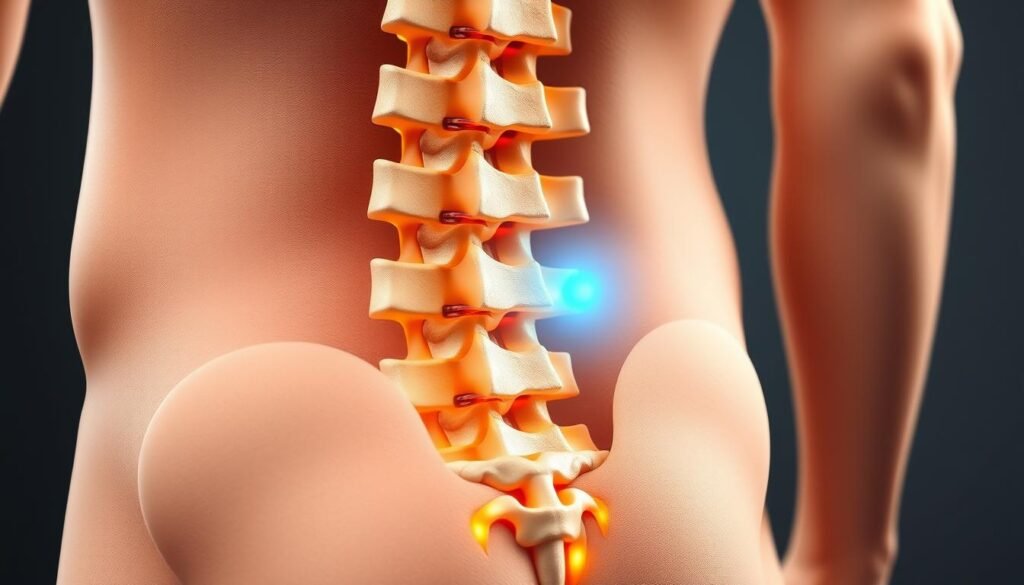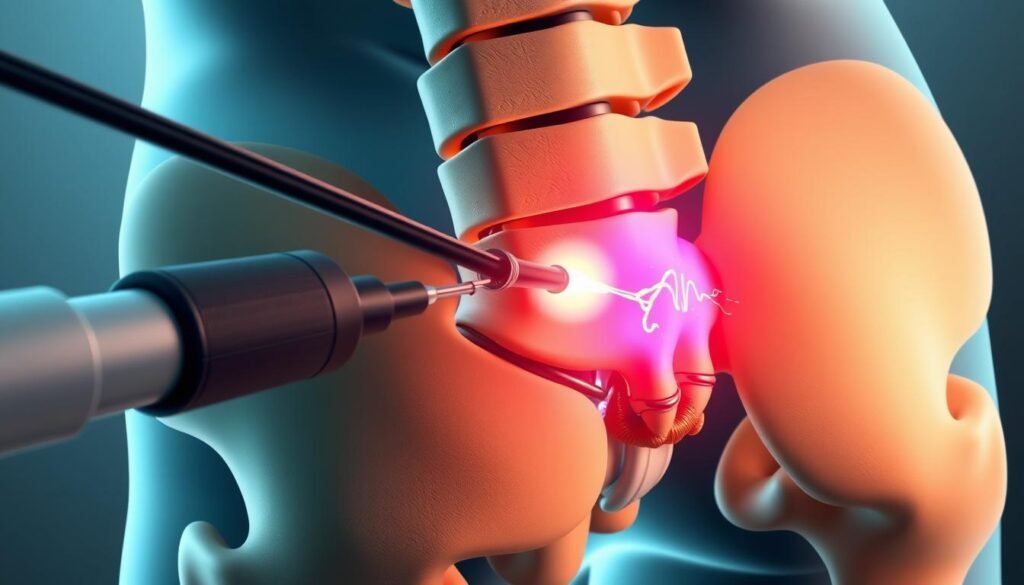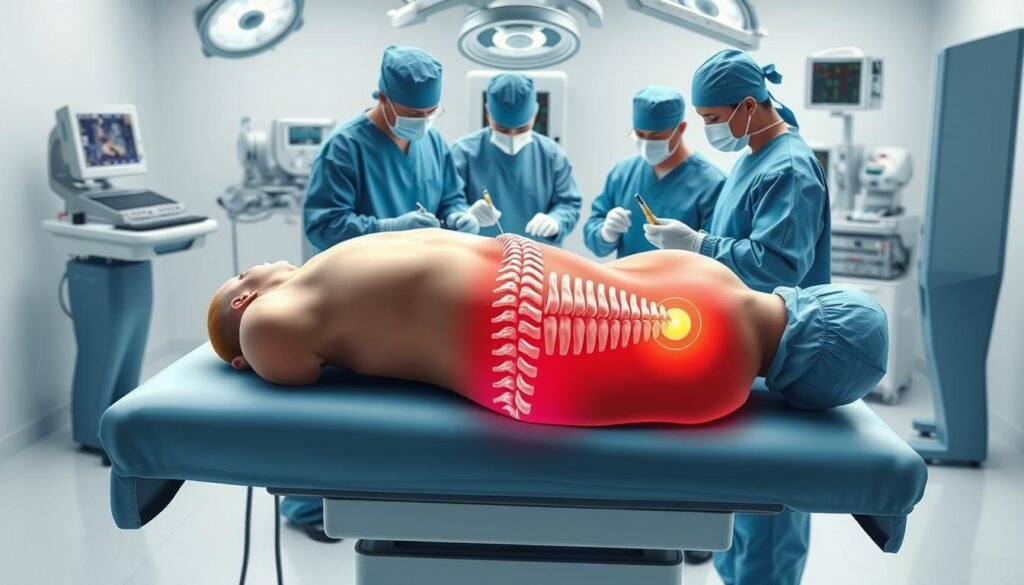Chronic back pain is a debilitating condition that affects millions of Americans, significantly impacting their quality of life. For many, the pain originates from the facet joints in the lumbar spine. Finding effective relief is crucial for those suffering from this condition.
Lumbar Radio Frequency Ablation is a minimally invasive procedure that has gained acceptance as an effective treatment option for chronic back pain. By using radio waves to heat a small area of nerve tissue, RFA destroys the nerve’s ability to transmit pain signals, providing significant pain relief.
The prevalence of chronic low back pain and the growing utilization of RFA underscore its potential as a viable treatment. This comprehensive guide explores the science behind RFA, the procedure, patient selection criteria, and expected outcomes.
Key Takeaways
- Understanding Lumbar Radio Frequency Ablation as a treatment for chronic back pain.
- The procedure’s mechanism in providing pain relief.
- The significance of facet joints in lumbar spine pain.
- Growing acceptance and utilization of RFA.
- Expected outcomes and benefits of the RFA procedure.
Understanding Lumbar Radio Frequency Ablation
For individuals suffering from severe back pain, Lumbar Radio Frequency Ablation offers a promising solution. Lumbar Radio Frequency Ablation is a medical procedure that utilizes radiofrequency ablation to treat chronic pain originating from the facet joints in the lumbar spine.
What is Radiofrequency Ablation?
Radiofrequency ablation is a minimally invasive procedure that uses heat generated from radio waves to target diseased tissue, specifically nerves that transmit pain signals. When radiofrequency is applied to nerve tissue, it damages the nerves, preventing pain signals from reaching the brain, thus resulting in pain relief.

The Science Behind Pain Relief
The mechanism of radiofrequency ablation involves controlled thermal denervation, where heat (typically 80-90°C) is applied to the nerve for 60-90 seconds, creating a lesion that disrupts the nerve’s ability to transmit pain signals. This procedure specifically targets the medial branch nerves that innervate the facet joints, which are often the source of chronic back pain, particularly in conditions like facet joint arthropathy or spondylosis.
The precision of modern RFA techniques allows practitioners to target only the pain-transmitting nerves while preserving nearby motor nerves, sensory nerves, and other structures, minimizing side effects and complications. Research has demonstrated that the thermal lesions created during RFA can provide significant pain relief by interrupting the pain signal pathway between the facet joints and the brain’s pain processing centers.
How Lumbar Radio Frequency Ablation Works
To understand how Lumbar Radio Frequency Ablation works, it’s essential to explore its mechanism of action on the nerves responsible for pain transmission. Lumbar Radio Frequency Ablation is a minimally invasive procedure used to treat chronic back pain by targeting the nerves that transmit pain signals.
The Role of Facet Joints in Back Pain
Facet joints in the lumbar spine play a significant role in back pain. These joints can become inflamed or irritated, causing pain. The medial branch nerves supply these joints, transmitting pain signals to the brain. Understanding the role of facet joints is crucial in appreciating how Lumbar Radio Frequency Ablation works.

Targeting Medial Branch Nerves
Lumbar Radio Frequency Ablation targets the medial branch nerves that supply the facet joints. By using radiofrequency energy, the procedure disrupts the pain signals transmitted by these nerves. This is achieved by creating lesions on the nerves, effectively interrupting their ability to transmit pain.
Creating Thermal Lesions
The creation of thermal lesions is the core mechanism by which radiofrequency ablation disrupts pain signal transmission. This involves the controlled application of heat (typically 80-90°C) to the targeted nerve for 60-90 seconds. Modern RFA systems use specialized probes that create spherical or cylindrical lesions around the needle tip, effectively interrupting the nerve’s ability to transmit pain signals.
The effectiveness of Lumbar Radio Frequency Ablation in providing pain relief is attributed to its ability to target the specific nerves responsible for transmitting pain signals, offering a significant reduction in chronic back pain for many patients undergoing the procedure.
Candidates for Lumbar Radio Frequency Ablation
The effectiveness of Lumbar Radio Frequency Ablation depends significantly on selecting the right candidates. This procedure is primarily used for patients suffering from chronic facet joint pain who have not found relief through conservative management options.
Ideal Patient Profile
An ideal patient for Lumbar RFA is one who has confirmed facet joint pain that has not responded to more conservative treatments such as physical therapy or medication. These patients typically undergo a diagnostic block to confirm that the facet joints are the source of their pain. For more information on facet joint pain and its management, visit this resource.
Contraindications and Exclusions
Certain conditions may exclude a patient from being a suitable candidate for Lumbar RFA. These include pregnancy, active infections, bleeding disorders, and the presence of certain implanted devices like pacemakers. Additionally, patients with significant psychological comorbidities or those whose pain is not related to the facet joints may not benefit from this procedure.
| Condition | Reason for Exclusion |
|---|---|
| Pregnancy | Safety concerns for the fetus |
| Active Infection | Risk of spreading the infection |
| Bleeding Disorder | Risk of uncontrollable bleeding |
| Implanted Devices | Potential interference with device function |
Understanding these criteria is essential for lumbar health management, ensuring that patients receive the most appropriate treatment for their condition.

The Diagnostic Process
Diagnostic medial branch blocks play a pivotal role in assessing the viability of lumbar RFA for patients with facet joint pain.
The process involves several key steps to determine if a patient is a suitable candidate for the procedure. One crucial aspect is the use of medial branch blocks.
Medial Branch Blocks
Medial branch blocks are a diagnostic tool used to determine if a patient’s pain is originating from the facet joints. This involves injecting a local anesthetic, such as lidocaine or bupivacaine, to temporarily block the pain signals from the medial branch nerves that supply these joints. The data indicates that in the year after a lumbar facet injection, 26.7% of patients received lumbar RFA, while 28.6% received another injection but not RFA.
Pain Relief Assessment
Pain relief assessment following diagnostic medial branch blocks is critical in determining candidacy for RFA. Specialists typically require at least 50-75% reduction in pain to consider the test positive. Patients are asked to perform their usual pain-provoking activities during the hours after the diagnostic block to accurately assess whether their normal pain has been reduced or eliminated. The duration of relief is also important, as it should correspond to the expected duration of action of the local anesthetic used.
The assessment often involves standardized pain scales and functional evaluation to determine the effectiveness of the block and the potential results of subsequent RFA treatment.
The Lumbar Radio Frequency Ablation Procedure

Lumbar radiofrequency ablation is a cutting-edge procedure designed to provide relief to patients with chronic lumbar pain. This procedure involves the use of RFA technology to target and treat the nerves responsible for transmitting pain signals to the brain.
Pre-Procedure Preparation
Before undergoing the lumbar radiofrequency ablation procedure, patients are typically advised on certain preparatory steps. These may include stopping certain medications that could interfere with the procedure or increase the risk of complications.
Step-by-Step Procedure Guide
The lumbar RFA procedure is performed under local anesthesia and mild sedation to ensure patients’ comfort. The steps involve identifying the target nerves, positioning the needle, and then using RFA to create a thermal lesion on the nerve to disrupt pain signals.
What to Expect During Treatment
During the procedure, patients remain awake and may receive mild sedation. They may experience some discomfort during needle placement and sensory stimulation testing, which can cause temporary sensations. Continuous monitoring of vital signs ensures patients’ safety throughout the treatment.
Recovery and Aftercare
After undergoing lumbar radio frequency ablation, patients typically enter a recovery phase that is crucial for achieving optimal pain relief. The success of the procedure depends not only on the technical aspects of the treatment but also on the post-procedure care.
Immediate Post-Procedure Care
In the initial days following the procedure, patients are advised to rest and avoid strenuous activities. The treatment site may be sore, but this discomfort usually subsides within a few days. It is essential to follow the specific instructions provided by the healthcare provider to ensure proper healing.
Long-Term Recovery Guidelines
Long-term recovery involves a gradual improvement in pain levels over the first 2-4 weeks. Patients are encouraged to gradually resume normal activities as comfort allows. A structured physical therapy program can be beneficial in restoring proper movement patterns and strengthening core muscles, which is an important aspect of long-term management. Follow-up appointments are typically scheduled to assess pain relief and functional improvement.

Effectiveness and Benefits
Patients undergoing Lumbar Radio Frequency Ablation often experience substantial pain relief and improved quality of life. This treatment has been shown to be effective for individuals suffering from facet-mediated low back pain.
Pain Relief Outcomes
Clinical studies have demonstrated that Lumbar Radio Frequency Ablation provides significant pain relief for patients. According to a study, a considerable number of patients reported at least 50% reduction in pain after undergoing the procedure. As one expert noted,
“Radiofrequency ablation has revolutionized the management of chronic pain, offering patients a minimally invasive solution with lasting benefits.”
Functional Improvement Statistics
The procedure not only alleviates pain but also improves functional ability. Studies have shown that patients who undergo Lumbar Radio Frequency Ablation often experience improvements in their daily activities and overall functional status. The benefits of this treatment are multifaceted, enhancing both pain relief and functional capacity.
Duration of Relief
The duration of pain relief following Lumbar Radio Frequency Ablation varies among patients. However, clinical studies consistently report average relief lasting between 6-12 months, with some patients experiencing benefits for up to 2 years. Factors influencing the duration include technical aspects of the procedure, patient-specific factors, and the underlying disease process affecting the facet joints. When pain returns, repeat procedures can be performed with similar effectiveness.
Potential Risks and Side Effects
While Lumbar Radio Frequency Ablation is generally considered safe, it’s crucial to understand the potential risks and side effects associated with the RFA procedure. As with any medical intervention, patients should be aware of the possible complications to make informed decisions about their treatment.
Common Side Effects
Common side effects of Lumbar RFA are typically mild and temporary. Radiofrequency ablation for back pain can sometimes result in minor discomfort at the procedure site. Most patients can resume their normal activities shortly after the procedure.
Rare Complications
Serious complications from lumbar RFA are rare when performed by experienced practitioners. However, potential risks include infection at the procedure site, nerve injury, and bleeding or hematoma formation. Extremely rare complications, such as spinal cord injury or pneumothorax, have been reported in case studies, highlighting the importance of proper technique and health monitoring during the RFA procedure.
Alternative Treatments for Facet Joint Pain
While lumbar radiofrequency ablation is an effective treatment for facet joint pain, other alternatives are available for patients seeking relief. Facet joint pain affects many individuals, and understanding the range of treatment options is crucial for effective management.
Conservative Management Options
Conservative management is often the first line of treatment for facet joint pain. This includes the use of medication to manage pain and inflammation. Additionally, physical therapy and lifestyle modifications can help alleviate symptoms. Conservative management options are typically less invasive and can be effective for mild to moderate facet joint pain.
Other Interventional Procedures
For patients who do not respond to conservative management, other interventional procedures are available. Intra-articular facet joint injections with local anesthetic and corticosteroids are one option, though they typically provide only short-term relief. Other alternatives include medial branch blocks with corticosteroids, which may offer longer relief, and regenerative medicine techniques such as platelet-rich plasma (PRP) or stem cell injections. Pulsed radiofrequency is another option for patients who cannot undergo traditional radiofrequency ablation.
Conclusion
The use of lumbar radiofrequency ablation has been increasingly recognized as an effective treatment for chronic back pain stemming from facet joints. Studies have consistently shown that 50-70% of appropriately selected patients experience significant pain reduction and functional improvement lasting 6-12 months or longer.
A comprehensive clinical evaluation and diagnostic medial branch blocks are crucial for identifying patients most likely to benefit from this procedure. As documented in various medical literature, including studies available on PMC, lumbar RFA represents a valuable tool for long-term pain management.
While it does not cure the underlying degenerative processes, it provides significant relief with minimal risk of complications when performed by experienced practitioners. For patients suffering from chronic low back pain originating from the facet joints, lumbar radiofrequency ablation offers the potential for significant improvement in pain, function, and quality of life.

